In the 1990s an expedition from Kew collected a bulb, not flowering at the time, in north-west Turkey. I’m reliably informed that it was tentatively identified as a Scilla species but, when it flowered, the white, pendant flowers proved to be inconsistent with this hypothesis. Aaron Davis quickly realised that this snowdrop was an undescribed species and, after a couple of abortive attempts, a few, small populations were located. This new species was published[1] in 2001, under the name Galanthus trojanus, a reference to the ancient city of Troy, which lies in ruins, not far from where the plants grow.
Two recent molecular phylogenetic studies of all or part of the genus agree that the ‘platyphyllus clade’, a group of three closely related species (G. platyphyllus, G. krasnovii and G. panjutinii) is sister to the rest of the genus[2]. That is to say, the most recent common ancestor of the platyphyllus clade and all other Galanthus species lived at a time not long after the origin of the genus, presumably somewhere in what is now the Caucasus. Sister to the rest of the genus is a clade containing the single species, G. trojanus. In other words, this species also split off from other snowdrops rather early in their evolutionary history. This is all much easier to visualise with a cladogram in front of you and I suggest seeking out the referenced papers, if you are interested[3].
This is all rather puzzling. What is a species of ancient origin doing, clinging precariously to existence, in a few woods in north-west Turkey, rather distant from the Caucasus? Is it a relict of a once much more widespread ancestral species, which is now extinct or has given rise to descendant species? Given that G. trojanus occurs in close geographical proximity to the current ranges of the younger species G. gracilis, G. plicatus, G. samothracicus and G. nivalis, how has it remained distinct?
These questions can’t presently be answered but they make G. trojanus a fascinating and enigmatic snowdrop. In spring 2015 I made two trips to north-west Turkey to try to find it. The first trip, in mid-February, coincided with a major snow storm, which buried the woods under a metre of snow but I returned a month later, in mid-March and succeeded in finding a tiny population, growing in deciduous, mainly oak woodland, on the very steep east-facing bank of a small stream, surrounded by fields. The only reason the fragment of woodland remained is that the slope was too severe to farm. Only a single plant was still in flower. The others in the population were already setting seed.
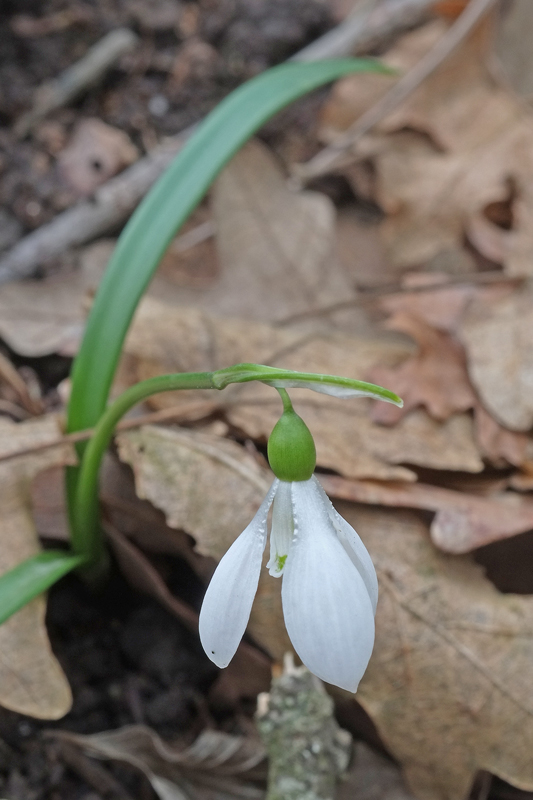
In early March this year, I returned to this site and found, to my intense frustration, that all the plants had already finished flowering. The photograph above, is of the single flowering plant I found in 2015.

The plants were scattered thinly across the slope and the entire population probably numbered only a thousand mature plants. Most were single bulbs but a few small clumps grew on the bank that separated the top of the small wood from the adjacent fields. Growing and flowering in stony, thin soil with the snowdrops were Anemone blanda, a Corydalis species, Crocus chrysanthus and Scilla bifolia. Dracunculus vulgaris was sending up its massive leaves.
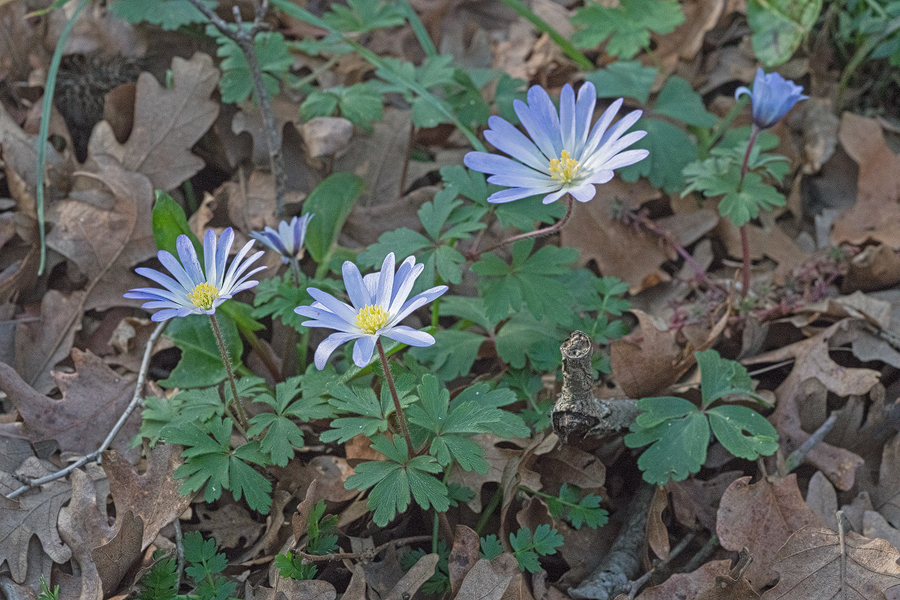

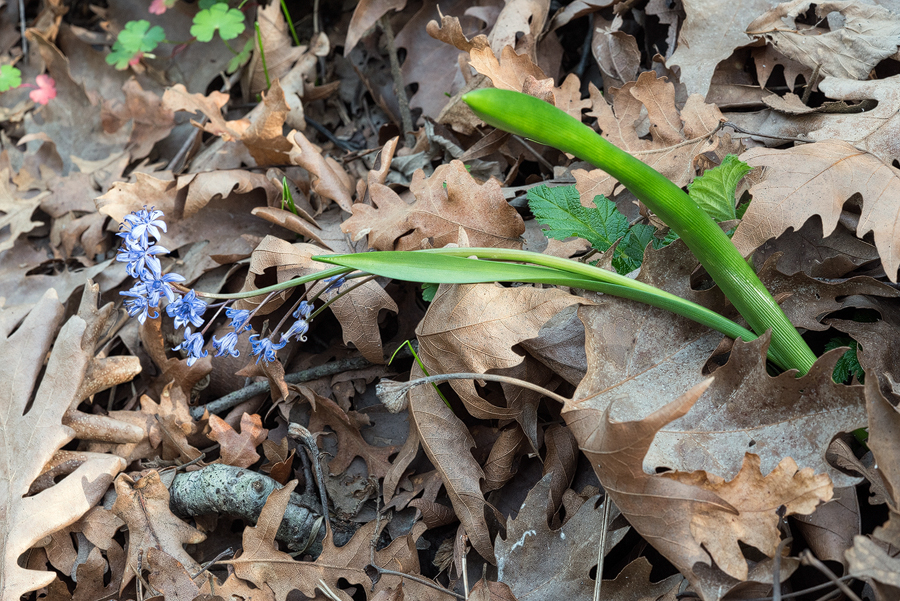
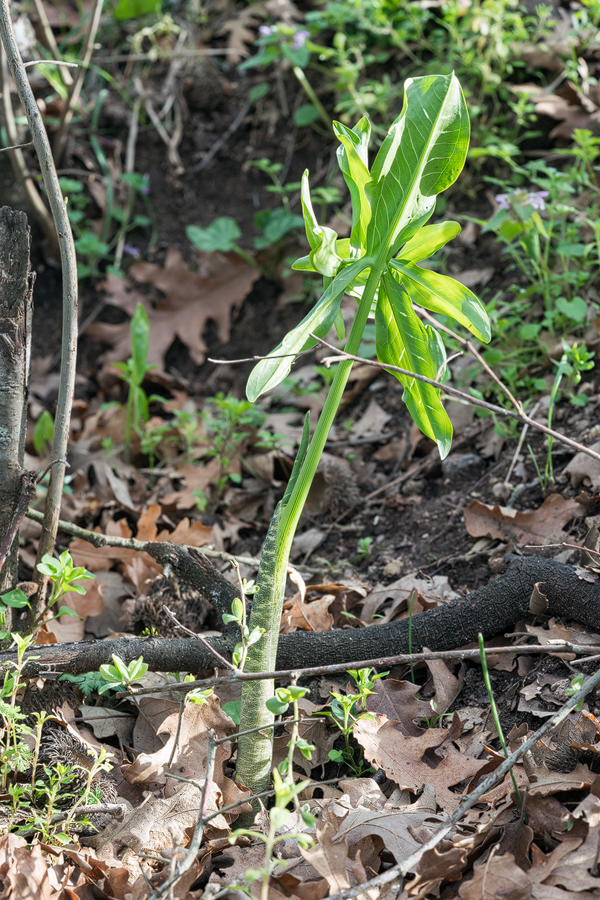
The leaves of the snowdrops were a matt or slightly glossy, mid-green colour, have applanate vernation and are rather narrow. They are quite unlike any of the other species that occur in north-west Turkey and are perhaps most superficially like those of narrow-leaves forms of G. lagodechianus or G. rizehensis.
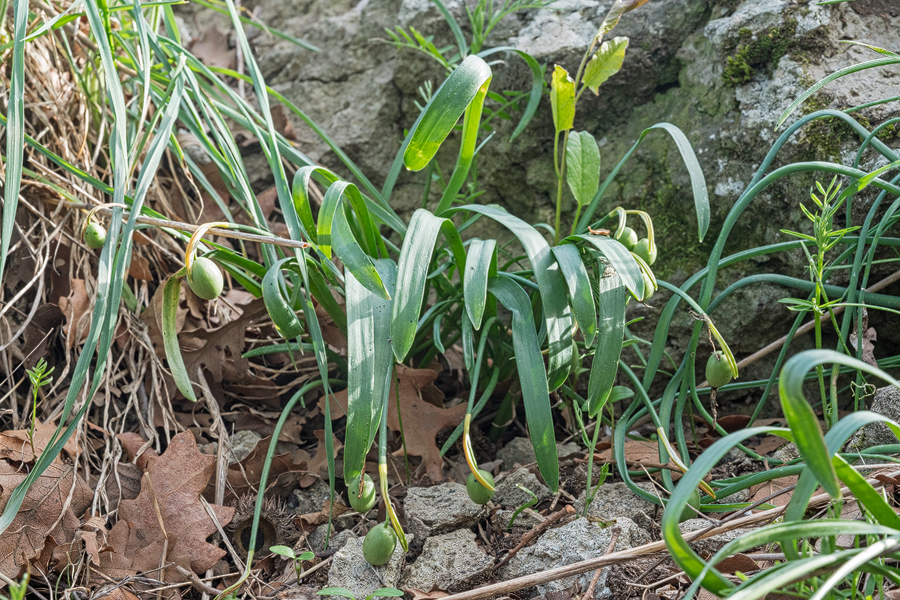
Quite a bit of seed was being set and the previous year’s crop of seeds were germinating healthily. Later in the day I discovered another small population, at higher elevation, which can have finished flowering only days earlier. Careful searches of the region would almost certainly reveal the existence of many more small populations but, nevertheless, this is clearly a species on the brink.
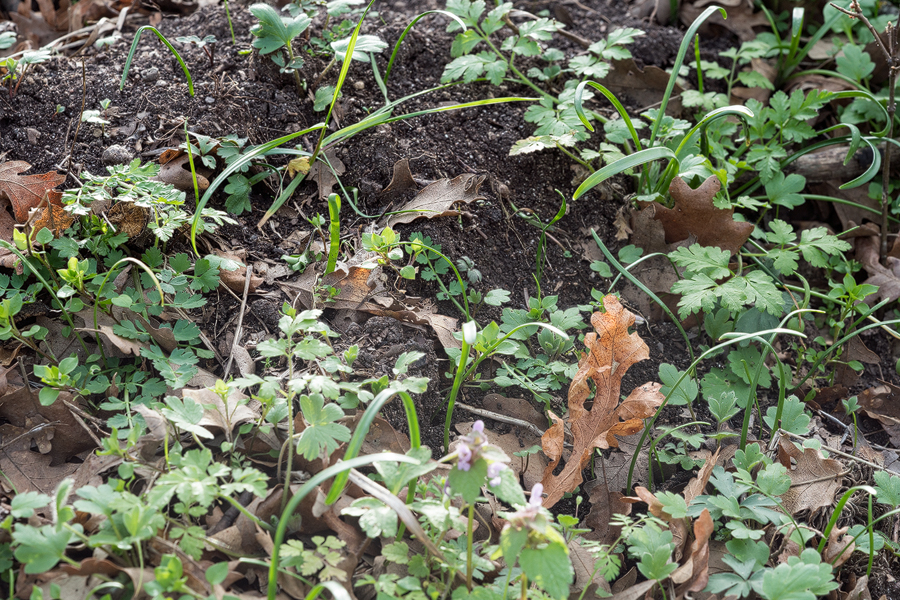
As an example of how conservation legislation often actively hampers a species’ chances of survival, G. trojanus is hard to beat.
As I have noted, it is rare, restricted to a small geographical area and grows in habitat where agriculture competes for use of the land. These are battles that agriculture always wins, in the end. If nothing is done, G. trojanus will become extinct in the wild, perhaps not in our lifetimes, though I wouldn’t bet on that.
But extinction is avoidable for all plants. Indeed, every time a plant species goes extinct it is as a result of human apathy or, worse, active choice. Plant extinction (but not animal extinction), in other words, is optional. Why? Because plant seeds can be stored in seed banks and living plants can be grown in gardens ex situ (that is, outside their current natural ranges). Those who stand in the way of these efforts are as morally culpable for the resulting extinctions as the concentration camp guards ‘just following orders’ were, for the deaths of the people who shuffled past them, on their way to the gas chambers[4].
Similar arguments were well made by Timothy Walker, former Director of Oxford Botanic Gardens, in a lecture at the Linnean Society, which was podcast.
I urge you to watch it!
There is a lonely pot of Galanthus trojanus, in a secret greenhouse at Kew. You can’t go and see it, unless you know someone on the inside. Kew isn’t allowed to propagate it (which would be easy) because of the Convention on Biological Diversity (CBD) which, some hilariously naïve enthusiasts claim, is our species’ best response to the sixth extinction[5]. The Convention says that ‘biological resources’ belong to the nation states in which they currently reside and that no-one else can use them, without permission and payment. Kew collected the snowdrop, with permission, on condition that it would not, under any circumstances (even the plant’s imminent extinction), give it to anyone else.
You couldn’t make it up. Kew, one of the world’s leading plant conservation organisations, is required to sit and wait for the inevitable death of the one, sad plant of G. trojanus officially in cultivation outside Turkey, rather than propagate it, distribute it and guarantee its long-term survival.
But that’s not all. The Genus Galanthus was added to Appendix II of CITES (the Convention on the International Trade in Endangered Species) in 1990. CITES was conceived to try to stem the trade in the parts of dead animals – elephant ivory, rhino horn, tiger skins, bear paws – and no-one outside the Chinese traditional medicine community disagrees that these are worthy objectives. Unfortunately, someone decided to include endangered plants in the scope of the treaty, despite the fact that plants can be kept, alive, ex situ without any of the ethical or technical issues that cloud the conservation of animals in zoos. Of course, there is a large trade in dead plants, for traditional medicine, but this trade is largely within countries and is therefore not governed by CITES.
Since 1990, therefore, it has been illegal to send snowdrops across international borders, for trade, without a permit, which is only ever granted for a handful of species (G. elwesii, G. nivalis, G. woronowii) and for hybrids of cultivated origin. You might think this is unequivocally a good thing. What could possibly be wrong with regulating trade in endangered plants? Surely no genuine conservationist could want to encourage the exploitation of wild populations of plants, to satisfy a whimsical appetite in enthusiasts for cultivating them.
There are several problems with this line of reasoning. First, the premises behind listing all Galanthus species on CITES – that they are all endangered and that international trade is a threat to their survival – are false. Second, it does not target the main threats to wild snowdrops species, agriculture and development. Finally, and perhaps most importantly, it actively hinders rescue efforts, when Galanthus species face existential threats from sources other than collecting.
Not all snowdrop species are endangered. Several (for example, G, nivalis, G. reginae-olgae, G. elwesii, G. gracilis, G. graecus, G. plicatus, G. lagodechianus, G. transcaucasicus and G. alpinus) occur across wide ranges in hundreds or thousands of populations, many of them in marginal habitats that are not presently threatened by development or agriculture. It is just silly to waste precious conservation effort on species that do not urgently need protection. Furthermore, arbitrarily listing species that are manifestly not threatened under laws designed to protect endangered species is likely to bring such laws into disrepute, which is likely to diminish public support for conservation.
Those species that are endangered (for example G. trojanus, G. cilicicus, G. fosteri, G. panjutinii) are not under threat as a result of excessive international trade but because human population pressure and the attendant development and expansion of agricultural land are resulting in inexorable habitat loss. Conservationists can bleat and rend their clothes all they like, but Turkey – for example – is simply not going to halt or slow its development aspirations for the sake of a few snowdrops. It is impossible, I think, for anyone to travel in these places, witness the pressures that impinge on wild plant species in the real world, and fail to grasp this basic fact.
The answer, albeit not one that an idealist would warm to, is to conserve these plants ex situ. Conservation resources are scarce and their allocation involves making difficult choices among competing worthy causes. In the case of Galanthus, there is a small but dedicated ready-made army of amateur enthusiasts, willing to contribute, at their own expense, to the ex situ conservation of rare snowdrop species in the genus. Conservationists (I am referring to the self-proclaimed, noisy variety) should be writing these volunteers thank you letters but, instead, they would like to criminalise them.
The urge to persecute someone, to deflect attention from the fact that nothing is actually being achieved, seems to be universal in bureaucracies, one of the reasons I detest dundridges so profoundly. Galanthus trojanus cannot be introduced as bulbs into cultivation outside Turkey because to do so would require a CITES permit, which that organisation will not issue. Even if a CITES permit could be obtained, Turkey would not grant permission for anyone to collect the plants because, according to the CBD, they belong to Turkey.
It’s like saying that the best, indeed the only place for Syrian refugees fleeing probable death at home is Syria and Syrians should on no account be allowed to go anywhere else. But no-one would be that stupid, would they?
It’s all so maddeningly Orwellian. Fortunately, however, there is a loophole. As I mentioned, Galanthus are listed in Appendix II of CITES unlike, for example, orchids, which are listed in Appendix I. The seeds of Appendix II plants are not covered by the ban on international trade and can be bought and sold perfectly legally, provided plant health laws are respected. As a result, G. trojanus is now widely cultivated, in many countries outside Turkey, and is therefore vastly less vulnerable to extinction than it would be if the government of Turkey[6], the bureaucrats at CITES, the dundridges who drafted the CBD and certain conservationists, who ought to know better, had had their way.
If the preceding paragraphs sound strident, it’s because I believe someone needs to start making these points, forcefully and no-one else is doing so. Virtually no-one seems willing to stick his or her head above the parapet. But, if we leave conservation to governments, bureaucrats and the sanctimonious, academic conservation biologists who trail from one pointless Conference of the Parties of the CBD to the next, leaving carbon dioxide and other hot gases in their wakes, we will continue, completely needlessly, to lose to extinction (and remember, boys and girls, extinction is for ever) plant species that could and should be saved. You read it here first.
[1] Davis, A.P. & Özhatay, N (2001) Galanthus trojanus: a new species of Galanthus (Amaryllidaceae) from north-western Turkey. Botanical Journal of the Linnean Society, 137: 4, 409-412.
[2] A clade is a lineage of organisms, all of which share a common ancestor and which includes every descendant of that common ancestor, whether extant or extinct. Clades can, in principle, be defined at any scale. For example, Homo sapiens constitutes a clade, as do primates, as do mammals. The Chinese do not, in contrast constitute a clade, nor do woody plants or marine mammals.
[3] Rønsted, Nina, et al. (2013) Snowdrops falling slowly into place: an improved phylogeny for Galanthus (Amaryllidaceae). Molecular Phylogenetics and Evolution 69: 205–217.
Margoz, N.T., Yüzbasįoglu, I.S. Çelen, T.E. , Ekim, T & Bilgin, A. N (2013) Molecular phylogeny of Galanthus (Amaryllidaceae) of Anatolia inferred from multiple nuclear and chloroplast DNA regions. Turkish Journal of Botany, 37:993-1107.
[4] There is a famous experiment in moral philosophy known as the trolley problem. See http://www.philosophyexperiments.com/fatman/ if you want to have a go at it yourself. If you’re not familiar with it and want to try it out, don’t read the rest of this footnote. You are standing by a set of points beside a railway line, watching a train approaching, fast. You notice that the train is going to smash into a group of five workmen, who are oblivious to its approach. You realise that, if you pull the lever operating the points you can divert the train onto a branch line. But there’s a problem. A single worker, equally oblivious, is working on the branch line. Would you pull the lever? Answer this question now, then consider the following scenario. You are standing on a bridge, overlooking a railway line and you see that a train is bearing down on five oblivious workmen. Standing next to you on the bridge is an immensely fat man and you notice that he is leaning over the railings, directly above a set of points. If you push the fat man off the bridge, he will divert the train onto a banch line. But there’s a problem. There’s a single, equally oblivious worker on the branch line. Would you push the fat man off the bridge? Most people say they would pull the lever in the first scenario but wouldn’t push the fat man off the bridge. Yet the two scenarios are morally identical. In both cases, you are condemning one man to die for the sake of saving five others. I think this problem has relevance for conservation. Those who spend their lives in nature, seeing and feeling the threats it faces feel morally obliged to act in its defence whereas those, a large majority, whose lives are divorced from nature, are able to rationalise fiddling, while Rome burns. I’d kill the fat man.
[5] If you haven’t heard this term, Google it, and start to fret.
[6] I don’t mean to pick on Turkey. It just so happens that more snowdrop species grow within its current borders than in any other country. It is also unfortunately true that, whereas some countries, for example South Africa, are willing to grant permission for plant and seed collection, under certain strict conditions, Turkey refuses to do so, to the detriment of plant conservation.
